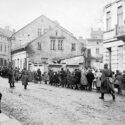Oświęcim
In 1939 the town of Oświęcim had a population of about 13,000. Its 8,500 Jewish residents were deported in March 1941 to make way for IG Farben staff. Construction also began on a new district, intended for German newcomers. The main square was renovated and renamed ‘Adolf Hitlerplatz’. A district was added in 1942 for IG Farben personnel and by 1943, about 8,000 Germans were living in the city. The IG Farben complex was ready to produce synthetic rubber and aviation fuel just before the camp’s liberation in 1945.
Oświęcim after the war
Following liberation, around 2,500 Polish residents were left at Oświęcim, a depopulated city with ultramodern factories. Some 40,000 workers were needed to operate Zakłady Chemiczne, the new name of the factory complex. Substantial Polish migration now occurred, resulting in an acute shortage of housing. Much of the Auschwitz I camp was therefore designated for residential use after the war. The former forced labour camps were also used for housing. Apartment complexes were built in the 1960s, by which time the housing shortage had begun to ease.



















